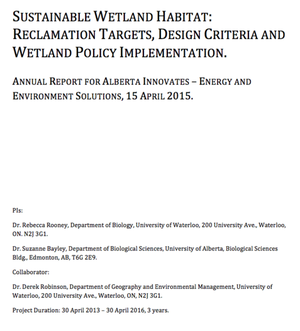Within a larger interdisciplinary research team, our lab is applying the reference condition approach at the landscape scale to quantify the properties, function, and the pattern of habitats in natural landscapes for comparison with reclamation efforts. Using remote sensing, geographical information systems (GIS), and ecological fieldwork we identify suitable reference areas to the oil sands region, but where human disturbance is low. Then we characterize the quantity and pattern of habitats and identify aggregate landscape properties that “fingerprint” naturally occurring landscapes in Alberta. A number of metrics are used to quantify edge characteristics, the degree of fragmentation, the shape of individual patches of habitat as well as across the landscape to fingerprint these landscapes. Global measurements of spatial autocorrelation and local indicators of spatial association are used to characterize the interrelationship among habitats within reference watersheds and sub-areas. By quantifying the pattern and properties of reference landscapes at multiple scales, and their variance among reference landscapes, we can define criteria and ranges of criteria values to guide closure-landscape planning towards a more natural appearance. Incorporating spatial assessments of naturally occurring ecohydrologic networks and ecosite distributions constitutes a major innovation in mine reclamation.
The project is funded by Alberta Innovates - Energy and Environment Solutions and has the capacity to fund one additional PhD on my project team. If this project is of interest then please send an email outlining your qualifications, unofficial transcript, and example of your writing.
Ecohydrologic approach to wetland reclamation in Alberta's Boreal Region
 We propose research to address several major reclamation challenges faced by thermal energy projects in Alberta’s oil sands region (Figure 1). These projects extract bitumen from the oil sands deposit using in situ mining techniques such as steam assisted gravity drainage, resulting in two major forms of disturbance to the peatland dominated boreal landscape: well pads and gravel pits. Our results will provide guidance on selection of reclamation targets and design criteria for reclamation of these two types of disturbance. By first characterizing appropriate natural landscapes and habitats in terms of their climate conditions, hydrology, chemistry, and biological function, we will generate reclamation targets based on the reference condition approach (Bailey et al. 2004) that will meet the criteria of being naturally appearing and self-sustaining, as stipulated in most Approvals under the Alberta Environmental Protection and Enhancement Act (GOA 1993).
We propose research to address several major reclamation challenges faced by thermal energy projects in Alberta’s oil sands region (Figure 1). These projects extract bitumen from the oil sands deposit using in situ mining techniques such as steam assisted gravity drainage, resulting in two major forms of disturbance to the peatland dominated boreal landscape: well pads and gravel pits. Our results will provide guidance on selection of reclamation targets and design criteria for reclamation of these two types of disturbance. By first characterizing appropriate natural landscapes and habitats in terms of their climate conditions, hydrology, chemistry, and biological function, we will generate reclamation targets based on the reference condition approach (Bailey et al. 2004) that will meet the criteria of being naturally appearing and self-sustaining, as stipulated in most Approvals under the Alberta Environmental Protection and Enhancement Act (GOA 1993).
Data
The following meta-data files describes the majority of the spatial data that has been compiled by members of the research team to date: Alberta Metadata (XLSX)
Annual report
Sustainable wetland habitat: Reclamation targets, design criteria and wetland policy implementation (PDF) summarizes the 2014 project research.
